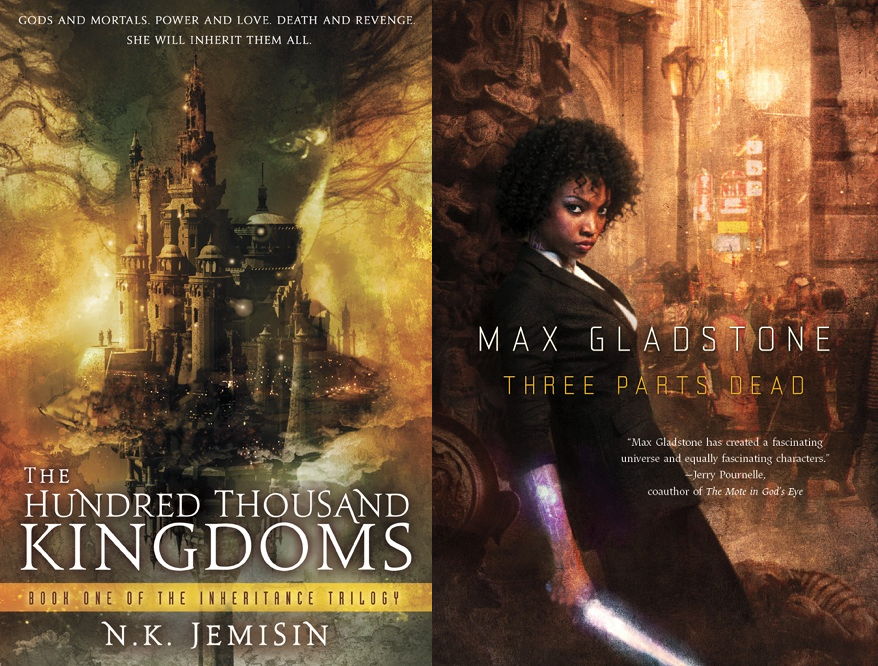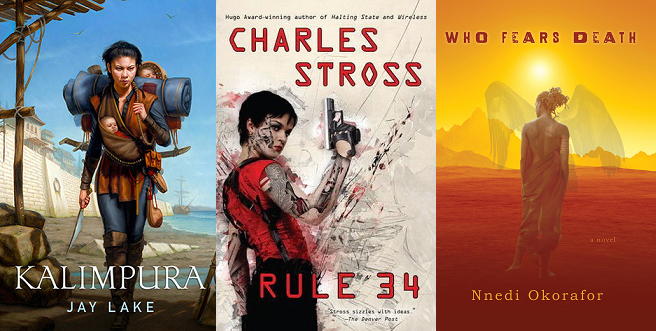Death and Rebirth of Gods

I’m in a period of pleasure reading right now — as opposed to research reading — and have been making a little progress in my quest to catch up on contemporary sci-fi and fantasy. Coincidentally, three of the recent books I picked up all dealt with the death and resurrection of gods. It seems appropriate to be reading these in the spring time. I’ve been watching the buds pop out on the trees and reveling in the appearance of crocii and cherry blossoms in my neighborhood. Plus, despite the secular life I’ve chosen as an adult, I still have a childhood nostalgia for Easter. I even found myself considering dyeing eggs, even though I never eat hard boiled eggs.
However, you won’t find much in the way of Christian symbolism (or Christian-flavored paganism) in these books.
The first book I picked up was The Hundred Thousand Kingdoms by N.K. Jemisin. I ran across Jemisin’s blog a while back when I was considering how to write about non-WASP characters and cultures despite my own WASP background. She blogged about the Revealing Eden discrimiflip, and whether a workable discrimination flip is even possible. I found her blog-writing to be clear and appreciated hearing her viewpoint, so I picked up her first book from my local bookshop. It took me a while to get into it — too much research reading and my own writing — but when I really sat down with it I enjoyed the twists and turns and the new mythology which she created. In the story, we enter into a world where there were once three sibling gods. One is dead, one reigns supreme, while the third, along with his various child-gods, is enslaved to the mortal family which rules over the eponymous hundred thousand kingdoms. Jemisin weaves together more symbolism than a Renaissance painting, and fleshes out her characters very well. I can’t think of a character, even a minor one, who didn’t stand out on the page with obvious personality. The question of plot becomes whether a god can remain enslaved, and whether a dead god can remain so.
While The Hundred Thousand Kingdoms starts out many generations after the death of a god, Three Parts Dead, by Max Gladstone, dumps the reader pretty quickly into the “crime scene” where our plucky main character is examining the body of a very recently deceased god. Gladstone lays out a fantasy world which, if you had to shoehorn it into a category, might be called steampunk since the dead god in question was a fire god who powered a lot of boilers which we get to explore through one of his priest-engineers. But our protagonist is not a priestess, she is a young necromancer, brought in to investigate the death of the god and the contracts which bound up his power. The plot question here revolves around rejiggering contracts and the remaining god-power to create a new entity that will satisfy the dead god’s contractual obligations. If that sounds dry, it wasn’t really. The legal process is continually disrupted by vampires and gargoyles and Hidden Schools floating in the sky. I did not have any trouble getting into Three Parts Dead; I had trouble putting it down.
I believe I found Three Parts Dead in the comments of a Jim C. Hines post. He’s done many posts on cover posing which you should definitely check out. This particular post included several examples of covers in which female characters were depicted realistically, i.e. wearing practical clothing. I figured it would be good to read some of these books since a) they were new and b) I want to support good cover art.
One of the pictured books was Kalimpura, by Jay Lake. It turns out to be third in a series, and since I hadn’t read the first two, I struggled with lack of understanding of the backstory, and put it down without finishing. However, I got far enough to pick up that the protagonist was responsible for shunting the power of a dead god into a brand new god.
So three books on gods dead and reborn or reworked passing through my hands just before Easter. Curious.
Two other books I read from their realistic cover feature were Rule 34 by Charles Stross, which was more gritty dystopian future scifi, and Who Fears Death by Nnedi Okorafor. Who Fears Death deals a lot with mythical power balance, and I really wanted to work it into the body of the post, but there aren’t any gods, really. But, it’s a post-apocalyptic fantasy coming of age novel which includes discussion of genocide, rape and female circumcision. While all of the books I’ve read lately have been pretty good, Who Fears Death is the one I will be pushing on my friends.

